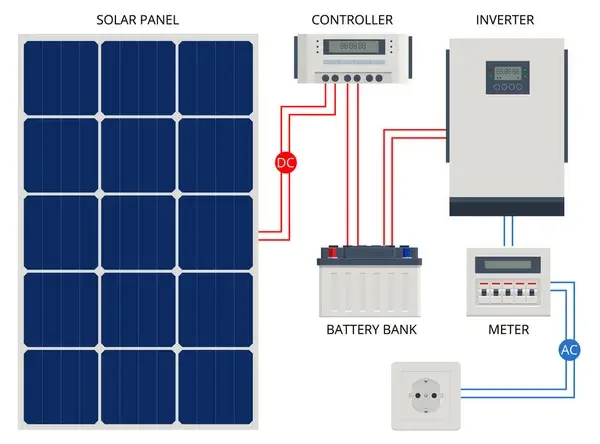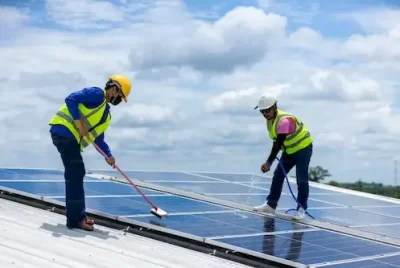Solar Power Overview: A Comprehensive Guide to Renewable Energy
We may earn a commission for purchases made using our links. See our disclosure to learn more.
This is a comprehensive overview of the rising star in the energy sector: solar power. In this solar power overview article, we will delve into the fascinating world of solar power, exploring its definition, advantages, technological advancements, environmental impact, and much more. By the end of this article, you will have a solid understanding of solar power’s potential and be equipped with helpful suggestions for embracing this sustainable energy source.
What is Solar Power?
Solar power is a form of renewable energy derived from harnessing the sun’s energy. It involves the conversion of sunlight into electricity or heat using various technologies. Solar power has gained significant attention in recent years due to its abundance, clean nature, and immense potential for sustainable energy generation.
Advantages of Solar Power
There are numerous advantages to adopting solar power
- Clean and renewable energy source, meaning it produces minimal greenhouse gas emissions and reduces our dependence on fossil fuels.
- Solar power can lead to significant cost savings over time, especially as technology advances and installation costs decrease.
- Solar power offers energy independence, as individuals and businesses can generate their electricity and reduce their reliance on the traditional power grid.
The Rise of Solar Power
Solar power has experienced a remarkable rise in popularity and adoption worldwide. The increasing awareness of climate change and the need for sustainable energy solutions has propelled solar power into the mainstream. Governments, businesses, and individuals have recognized its potential and have been investing heavily in solar power installations. This surge in demand has led to improved technology, increased efficiency, and decreased costs, making solar power a viable option for many.
Solar Power Technology
Solar power encompasses various technologies, with the two most common being photovoltaic (PV) and solar thermal systems. PV systems utilize solar panels to convert sunlight directly into electricity, while solar thermal systems use the sun’s heat to generate electricity or provide hot water. These technologies continue to evolve, offering higher efficiency and better performance.
Solar Power Systems
Residential and commercial solar power systems are becoming increasingly accessible and affordable. Residential systems consist of solar panels, an inverter,
and a solar power meter. These components work together to capture sunlight, convert it into electricity, and supply it to the household. Commercial solar power systems are larger in scale and often involve multiple panels and advanced monitoring systems.
Financial Incentives
To encourage the adoption of solar power, various financial incentives and subsidies are available. These incentives can include tax credits, rebates, and net metering programs. They help offset the initial investment and make solar power more financially feasible for individuals and businesses.
Environmental Impact
Solar power plays a vital role in reducing carbon emissions and combating climate change. By utilizing a clean and renewable energy source, we can significantly reduce our reliance on fossil fuels, which are major contributors to greenhouse gas emissions. Solar power also helps to preserve natural resources and protect the environment for future generations.
Overcoming Challenges
Although solar power offers numerous benefits, it does face certain challenges. One challenge is the intermittent nature of sunlight, which can affect consistent energy generation. However, advancements in energy storage systems, such as batteries, are mitigating this issue. Another challenge is the initial cost of installation, but as technology improves and economies of scale are achieved, the upfront investment is becoming more affordable.
Future of Solar Power
The future of solar power looks promising. Continued research and development are driving advancements in solar panel efficiency, storage systems, and integration with smart grids. Innovations such as transparent solar panels and solar-powered devices are also on the horizon. With ongoing technological breakthroughs, solar power has the potential to become the dominant source of energy worldwide.
Integration with the Power Grid
Solar power integration with the existing power grid is crucial for effective energy distribution. Through the implementation of smart grid systems, excess solar energy can be stored and supplied back to the grid when needed. This integration ensures a reliable and stable power supply, even during periods of low sunlight.
Global Solar Power Initiatives
Numerous countries and organizations are leading the way in solar power initiatives. For example, Germany has made significant investments in solar power and has become a global leader in solar energy production. Similarly, organizations like the International Solar Alliance are working to promote solar power adoption and collaboration on a global scale.
Solar Power in Developing Countries
Solar power has immense potential to transform energy access and sustainability in developing countries. With limited infrastructure and energy resources, solar power offers a decentralized and cost-effective solution. It can provide electricity to remote areas, power schools, and healthcare facilities, and improve the quality of life for millions.
Choosing Solar Power
If you’re considering embracing solar power, here are a few helpful tips:
1. Assess your energy needs: Determine your energy consumption and evaluate how solar power can meet your requirements.
2. Consult with professionals: Engage with solar power experts to assess the feasibility of solar installations on your property and get accurate cost estimates.
3. Research available incentives: Explore the financial incentives and subsidies offered by your government or local utility companies to maximize cost savings.
4. Select a reputable installer: Choose a trusted solar power installation company with experience and positive customer reviews.
5. Monitor your energy production: Install a solar power meter to track your energy generation and consumption, allowing you to optimize your system’s performance.
Conclusion
The world has witnessed a remarkable surge in the popularity of solar power, establishing it as a prominent player within the renewable energy sector. When considering a solar power overview, it becomes evident that this form of energy has garnered significant attention due to its multitude of benefits, impressive technological advancements, and positive impact on the environment. As more individuals and businesses embrace solar power, we collectively contribute to forging a sustainable future reliant on clean energy sources. Furthermore, the adoption of solar power offers the advantages of cost savings and energy independence, making it an increasingly attractive option for a wide range of stakeholders.
FAQs (Frequently Asked Questions)
1. Is solar power only suitable for sunny regions?
• Solar power can be harnessed in various regions, regardless of the amount of sunlight. Solar panels can generate electricity even on cloudy days, although their efficiency may vary.
2. How do I maintain and clean solar panels?
• Regular maintenance of solar panels involves cleaning the surface to remove dust, debris, or any obstructions that may hinder their performance. Cleaning can be done with water and a soft cloth or with specialized solar panel cleaning equipment.
3. What is the lifespan of solar panels?
• Solar panels typically have a lifespan of 25 to 30 years. However, their efficiency may slightly decrease over time. It’s important to choose high-quality panels and ensure proper maintenance for optimal performance and longevity.
4. Can I sell excess solar power back to the grid?
• Yes, many countries have net metering programs that allow you to sell excess solar power back to the grid. This means you can earn credits or receive compensation for the surplus energy your system generates.
5. Are there any government incentives or subsidies for installing solar power systems?
• Yes, many governments offer incentives and subsidies to promote solar power adoption. These can include tax credits, rebates, grants, and low-interest loans. Check with your local government or energy authority to explore the incentives available in your region.
6. Can I install solar panels on a rented property?
• In some cases, it is possible to install solar panels on a rented property with the permission of the property owner. However, it’s important to discuss the feasibility and potential agreements with the landlord before proceeding.
By embracing solar power, you not only contribute to a sustainable future but also enjoy the benefits of clean energy and potential cost savings. Make sure to research, consult with professionals, and explore available incentives to make an informed decision about adopting solar power. Together, we can make a positive impact on the environment and our energy consumption.




